Pellet heating boilers: types, advantages and rules for choosing the best boiler
If there is no main gas pipeline nearby, then modern pellet heating boilers will be the most effective and economical option for heating residential or non-residential buildings. In addition, such units are characterized by durability, the ability to operate autonomously and safety.
To ensure that the operation of the boiler does not cause trouble, and the purchase does not disappoint, it is necessary to carefully approach the issue of choosing equipment.
We will help you in this matter. The article presents the pros and cons of pellet boilers, indicates the features of their operation and maintenance, and also describes in detail the characteristics and parameters that should be taken into account when purchasing.
The content of the article:
Main characteristics of pellet boilers
All pellet boilers are designed for heating buildings. In addition, these products can provide hot water. True, this function is additional, so it is not provided in every product.
The main feature of such solid fuel boilers is high automation. They use compressed wood granules called pellets as fuel.
For the equipment to work, the owner only needs:
- at intervals of several days, or even weeks, months (it all depends on the size of the bunker), ensure a supply of fuel;
- perform simple maintenance - it mainly consists of cleaning out the ash and takes only a few minutes.
Boilers that receive energy from burning pellets are used to heat private and apartment buildings, cottages, hotels, office and industrial buildings, and shops. If you need to heat a separate room, you can use pellet stoves with the lowest productivity.
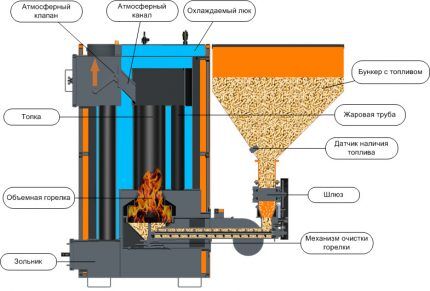
Advantages of pellet equipment
Today, the advantages of boilers running on pellets are significant, which makes them in demand. One of the most important advantages is high efficiency, it reaches 80-97%. It is comparable to the most recognized heating equipment - gas boilers.
It is important that efficiency is ensured by cheap fuel - pellets are made from wood waste (shavings, pressed sawdust various deciduous or coniferous species), thanks to which their cost is second only to gas.
Moderate fuel prices coupled with high efficiency ensure the equipment is economical. In Russia, this is the cheapest type of heating after gas; in a number of post-Soviet countries (for example, Ukraine) it is even the most affordable.
For example, using a pellet boiler will cost 1.5 times less than similar equipment running on coal. And heating a building using electric boiler 2-3 times more expensive.
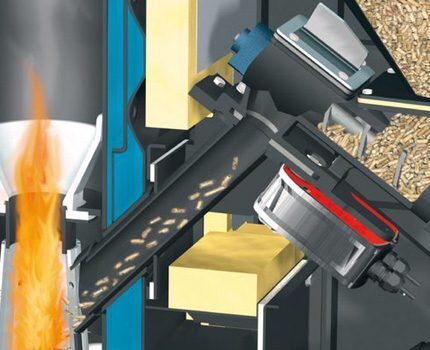
An important advantage is autonomy in operation - it is achieved by a high level of automation. For example, the boiler itself is capable of supplying the required amount of pellets into the firebox, controlling the temperature regime set by the owner, and stopping and starting operation. Often the equipment is even able to clean itself of ash.
Autonomy ranges from 2-15 days, and if the automated boiler is provided with an uninterrupted supply of fuel, it can operate without human intervention throughout the cold season. Also, these units are independent of the presence of centralized heating and main gas pipelines.
We must not forget about environmental friendliness - pellets are compressed sawdust, they do not contain glue or other binders. This guarantees the absence of harmful substances (for example, sulfur) in the granules; their ash content is tens of times lower than that of firewood, as is the emission of carbon dioxide.
Another important advantage is safety. To ensure this, a multi-level fire protection system is used, which includes control sensors, electronics that interrupt the supply of pellets, automatic shutdown, and a number of boilers are equipped with alarm systems.
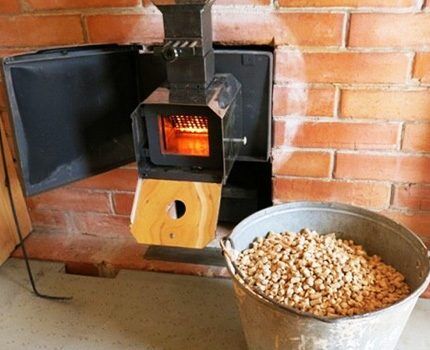
An important advantage is the simple installation - the boiler owner does not need to obtain any permission or draw up a project. Current rules allow the installation of such equipment in utility rooms, basements, corridors, and kitchens. Besides, pellet boiler piping you can do it yourself.
Types of pellet equipment
Any pellet boiler is solid fuel, therefore it has all the features of such products. That is, steel and cast iron are used for its manufacture, and the design consists of traditional elements: a body, a firebox, a heat exchanger, and the chimney is still there.
But there is also a “zest” - a burner that works together with electronics and a mechanism for supplying fuel to the firebox. This design element significantly affects the characteristics of any boiler, therefore, according to their characteristics, boilers are divided into types.
There will be no particular difficulties in choosing the type of burner - there are only three options:
- flare;
- volume;
- fireplace
Flare burners differ in the following advantages: compactness, durability, unpretentiousness. Also, these products are characterized by relatively low productivity, therefore they are used only for installation in domestic boilers of moderate power.
It is recommended to choose them if the equipment will be turned on/off frequently (for example, in dachas where people do not live permanently). This is also the best option for universal boilers, that is, those that use different types of fuel.
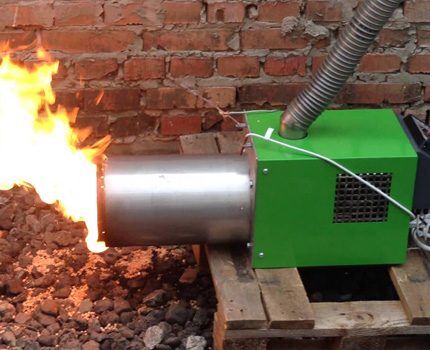
Another important feature of all flare burners is sensitivity to the quality of pellet fuel. Such equipment can operate effectively and for a long time only on moderately moist pellets that retain their shape until they enter the burner with a low content of sand and other impurities.
Volume burners - These are the most productive and efficient among other types. Therefore, they are installed in powerful domestic and industrial boilers. They usually have a larger mass than their flare counterparts. Also, such equipment is insensitive to fuel quality.
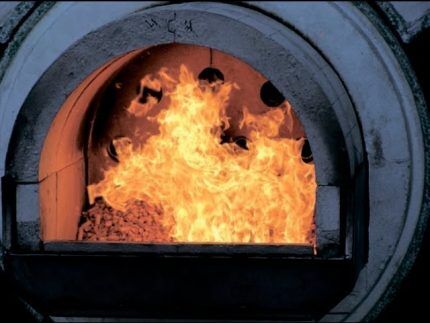
Fireplace burners — are intended for installation only in the smallest boilers (stoves-fireplaces). They are sensitive to fuel quality.
Also, this type of burner is characterized by moderate performance, but due to the simplicity of its design, it has the highest reliability.
All pellet boilers are divided into groups according to their intended purpose.
It’s easy to understand this issue, since there are only two varieties:
- heating boilers;
- stoves-fireplaces.
Heating boilers - serve for heating and providing hot water supply. Usually their power starts from 13-15 kW, maximum performance is 2 megawatts.They are distinguished by their massiveness and unpretentious appearance. Such equipment is installed in the basements of houses and individual buildings.
Stoves and fireplaces - serve to heat the room in which they are installed. They are compact, quiet in operation, and have an attractive appearance.
Additionally, all pellet boilers are divided according to the level of automation into the following types:
- automatic;
- semi-automatic;
- mechanized.
Automatic boilers. It is extremely rare that one will have to contribute to the uninterrupted operation of such products; usually he is required to start the boiler in the fall and turn it off in the spring. Everything else is controlled by the processor - fuel supply, ignition, cleaning the heat exchanger and even removing ash.
But such equipment will not be available to everyone because of its high cost, complexity of design, and expensive installation, as it requires many precise adjustments of the electronics.
In addition, automatic products will demonstrate their maximum qualities if the fuel supply is large, that is, a warehouse of at least several cubic meters in size is needed. And if the bunker has to be loaded frequently, then the point of paying significant money for such equipment is lost.
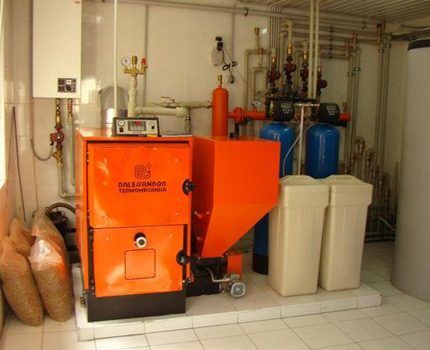
Semi-automatic products usually differ from automatic boilers only in that the ash pans must be cleaned manually. But this procedure does not cause any difficulties even for people unfamiliar with such equipment.
In addition, the cleaning procedure is short and takes only a few minutes (no more than 15-20). And it is rarely performed - usually no more than once a week).
Mechanized boilers - the most common group. There are several reasons for this, for example, they are compact, most affordable, and simple in design, which increases reliability.
Since the level of automation is somewhat lower than in other cases, a person will have to clean the heat exchanger and ash pan on their own, but this is not at all critical. This procedure is usually simple, takes little time, and the frequency depends on the quality of the pellets and the intensity of use of the boiler.
Since the hopper of a mechanized product is relatively small in size, it will have to be loaded manually after a few days. The exact frequency depends on the operating mode (more often in cold weather, an order of magnitude less often in the off-season).
All equipment that uses pellets for operation is universal – this applies to the type of fuel used.
There are boilers of the following types:
- pellet;
- conditionally combined;
- combined.
Boilers classified as pellet boilers can only operate on wood pellets. More universal conditionally combined products allow the use of alternative types of fuel, for example: briquettes, firewood.
But there is an important condition - any type of fuel, except pellets, should be used only in exceptional cases and for a short time. The reason for this is the design of the boiler.
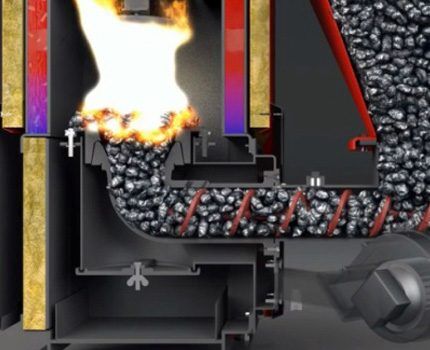
Usually, the ability to use alternative fuel is provided by additional design elements, for example, the kit often includes a grate, which is mounted in the firebox if the pellets run out.
The combined type of equipment allows the use of several types of fuel on an ongoing basis. This possibility is achieved due to the presence of several fireboxes. This solution makes the boiler as versatile as possible, but also makes it more bulky and expensive.
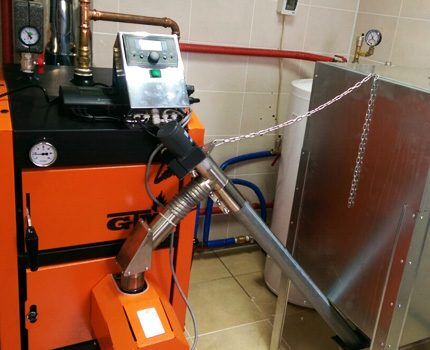
An important point is the characteristics of the pellets themselves and their quality. The fact is that the automation of the presented equipment is designed only for granules of a certain type and quality. Therefore, before purchasing, you need to learn how to choose the right fuel.
What you need to know about pellets?
Wood pellets used as fuel come in different sizes depending on the standards adopted by the state. Thus, pellets produced in the European Union reach a length of 30-60 mm. In Russia, where the rules have not yet been established, the granules may be longer.
Therefore, if you use such a product for a boiler manufactured in Europe, it will be difficult to configure the automation to the desired mode. As a result, overexpenditure, incorrect operation in modes specified by the owner, etc. are possible.

Also, all heating boilers operating on pellets require that they be of sufficient quality. That is, the granules must retain their shape until they enter the firebox. Otherwise, overspending is inevitable.
The strength of pellets depends on the quality of production and humidity. It is important that it does not exceed 12%. If the norm is not observed, the calorific value will decrease, and in severe cases the granules will become completely unusable.
This type of fuel is:
- household (ash content up to 1%) - they are made from hardwood waste with minimal addition of bark;
- industrial (ash content up to 3%) - it is made from coniferous waste with the addition of bark (up to 10%);
- from agricultural waste (ash content more than 3%) - they are made from biomass of various origins (sunflower husks, straw).
Granules for household use are characterized by the highest calorific value, as they contain a small amount of dust and have low humidity. They are always white.
Cheaper ones are granules for industrial use. Low cost is their significant advantage. Their disadvantage is not the highest calorific value. In addition, the boiler will have to be cleaned much more often and this procedure will be more labor-intensive.
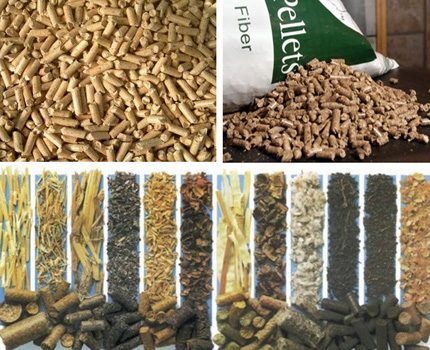
There is another type of pellets made from agricultural waste. But you shouldn’t use them - they have extremely low calorific value and high ash content. This means that the boiler will become clogged often, and in this case it is quite difficult to clean it, especially with frozen ash.
You can set up the production of pellets yourself; more information about the manufacture of a special press is written in this article.
How to choose the right equipment
Even before deciding to purchase a pellet boiler, you should understand a number of points in order to avoid significant financial losses. It so happens that, in a hurry with the purchase, the owner cannot install the purchased equipment or fully operate it.
What to look for before buying
So, before buying, you should understand several nuances.
Firstly, make sure whether it is possible to place the necessary equipment in the building. Usually it is installed on the ground floor, in the basement.
It is necessary to take into account not just the expected dimensions of a particular product, but also the requirements for its installation, for example, there must be gaps of 700 mm or more between the components of the boiler.
Secondly, you need to figure out whether it is possible to store fuel in the required quantity. It is also necessary to pay attention to the convenience of its delivery to the boiler (delivery from the supplier, movement from the storage location to the bunker). And fuel should only be stored in a dry room.
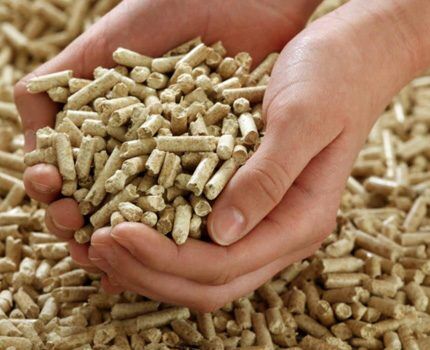
Thirdwhether the power grid is sufficient. Since the control unit, together with the sensors, and the ignition system are powered by electricity, for normal operation, for a short period, they can create a significant load.
This happens during the boiler ignition procedure, when a special heating element raises the temperature in the combustion chamber to an impressive 1000°C so that the pellets ignite.
The line of boilers from the Teplodar company includes combined boilers COOPER PRO, which can be used as both solid fuel and pellet:
Take care of fuel in advance
Also, before purchasing a boiler, you should find out whether there are organizations nearby that supply pellets. There should be several sellers - if there is only one and suddenly ceases to exist, then problems with operation will begin.
It is also necessary to pay attention to the fact that it is usually cheaper to buy fuel from the manufacturer. To prevent any accidents, a potential buyer of pellets should familiarize themselves with the sellers' offers before purchasing.
It is advisable to contact them directly and find out all the details - delivery costs, whether the organization will be able to deliver regularly, etc. And for industrial expenses, it is best to sign a supply agreement with the supplier before purchasing.
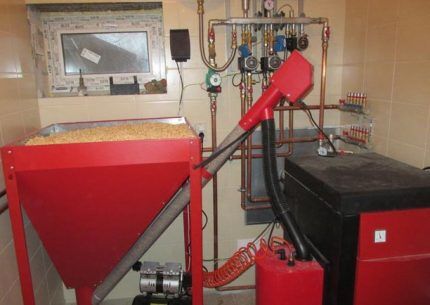
Rules for choosing a pellet boiler
If there are no doubts about the possibility of installation and the provision of fuel, then you can proceed to choosing a boiler.This should be done by calculating the power.
Theoretically, it is not difficult to calculate - all manufacturers indicate this characteristic in their data sheets, and for simplicity they add how many square meters the boiler is ready to heat.
For example, if the description says that the power is 30 kW, then the manufacturer will indicate that his boiler is capable of heating 200-300 square meters. m of premises. But all these are average values, which are of little use for determining exact values.
Also, any person can perform the calculation himself, since it is believed that 1 kW of power is needed for every square meter. The formula is relevant only for buildings with insignificant heat loss. Effective heat-insulating materials were used in their decoration, and the doors and windows also matched them.
Otherwise, it is necessary to calculate heat loss, which only a specialist can do. This will cost money, but it will guarantee that the building will be warm and you won’t have to overpay for it.
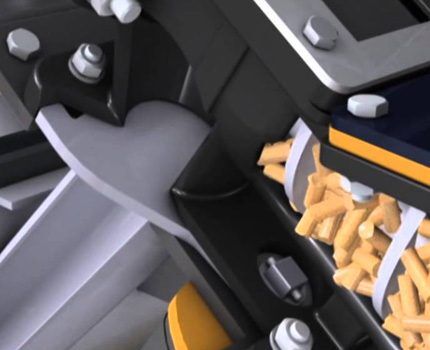
In addition to the rated power, it is worth considering such a moment as its modulation. Although it sounds incomprehensible, everything is simple here - this is the ability of a pellet boiler to operate at conditions below its maximum productivity.
This is true for regions where temperatures are not the coldest for most of the season. Therefore, heating equipment does not need to operate at full capacity, but rather use only 30-40% of it.
If the boiler does not have such an opportunity, then, at first glance, this is not a problem - having reached the highest temperature specified by the user, it will turn off.When it drops to the minimum set level, it will turn on again. But during such switching on/off wear occurs, which significantly reduces the service life of the equipment.
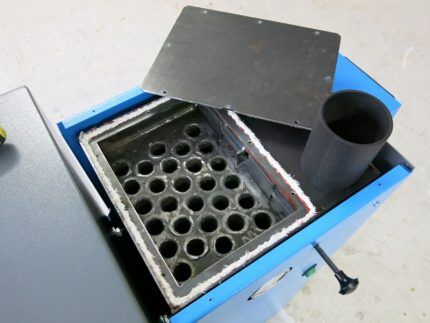
You should also pay attention to dynamic power. The owner may encounter this characteristic rarely, but in unpleasant moments (if the boiler is chosen incorrectly).
To understand dynamic power, it is enough to look at an example: there was a sharp drop in temperature and the boiler began to not cope with heating.
If it has enough opportunities to briefly, but significantly, increase its productivity and quickly bring the temperature to the set point, then the boiler has sufficient dynamic power. If this does not happen, then the specified characteristic is insufficient and it is better not to buy a boiler - it will sometimes make the owners freeze.
How to choose the right equipment model
When the power is determined, you can proceed to choosing a model. At this point, the potential buyer will understand that there are many manufacturers, as well as models. In order not to get confused in this variety, you should decide which boiler to buy from a well-known domestic or foreign manufacturer.
You should only buy equipment from a well-known seller in the country or region who provides service, updates of all software, and repairs of the sold boiler.
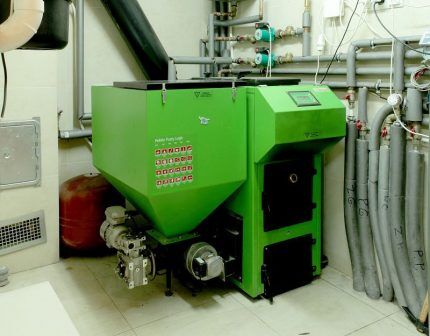
Also, when choosing, you should pay attention to the type of model you like, advantages, versatility, etc.
But in any case you need to check:
- is the boiler certified by Rostechnadzor;
- are there conclusions from independent specialized institutes confirming the high efficiency of the selected equipment and the amount of harmful emissions;
- is there a fire extinguishing system and can the boiler automation prevent a “backfire” when for some reason the flame begins to move from the burner to the hopper;
- what methods are used to prevent overheating of a working boiler.
Since the boiler will operate in different modes, it is worth checking information about efficiency and emissions in all of them. It would also be a good idea to check the noise level and worry about safety.
In addition, you should look at how easily the equipment is programmed, controlled, and whether it has automatic ignition so that all household members can handle it. Cleaning the product from ash should also be simple.
Since the boiler will be connected to other heating equipment, you always need to find out the standards, connection diagram, manufacturer’s requirements in this case, and pipe diameter. The last point is especially relevant if they are already installed or purchased.
Conclusions and useful video on the topic
Advantages and disadvantages of heating with pellets in a video clip:
The video provides an overview of the pellet equipment market:
What is a pellet boiler and its comparison with an electric one in the video:
Choosing a pellet boiler is a responsible procedure. To do this, it is necessary to pay some attention to studying the features of this equipment.It is also important not to save money, but to give preference to a product made in Europe.
Since the durability of boilers strongly depends on the quality of materials, the sufficient thickness of its body, and compliance with all standards is guaranteed only by manufacturers from the European Union.
Are you looking for a reliable and efficient pellet boiler? Or do you have experience using such heating units? Please leave comments on the article, ask questions and participate in discussions. The contact form is located below.




An excellent alternative to coal and firewood, no dust, no dirt, and there are no problems with ash disposal - a useful fertilizer for the site. The main problem is with the pellets. Now everyone who is not too lazy has started making them. To choose good fuel, you will have to look through many local manufacturers. The required level of fuel moisture can be achieved only from a mixture of dry sawdust (50%) with wet sawdust. And manufacturers think that they put the machine on their sawmill and make pellets from free production waste. But no, it won’t work like that, the sawdust needs to be specially dried.
1 kW per 1 square meter of area? There is an error in the article. A 30 kW boiler will heat a building of 200-250 sq.m. no problem, with ordinary walls...